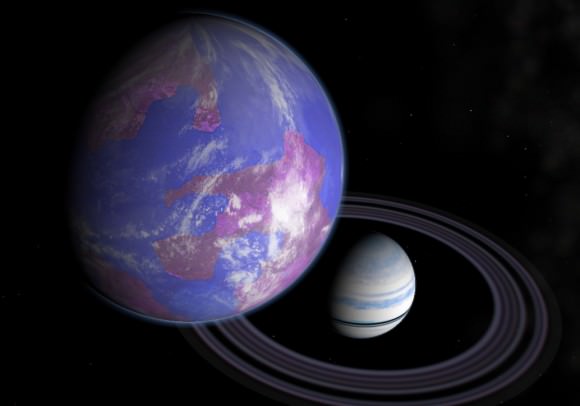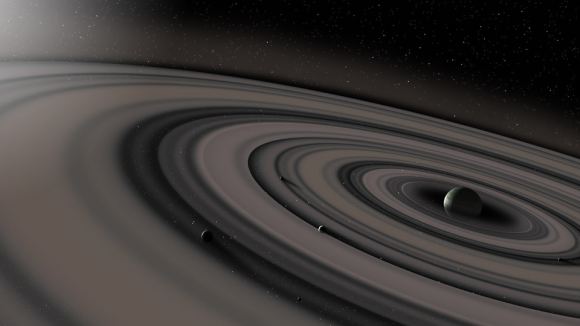KIC 8462852 (aka. Tabby’s Star) continues to be a source of both fascination and controversy. Ever since it was first seen to be undergoing strange and sudden dips in brightness (in October of 2015) astronomers have been speculating as to what could be causing this. Since that time, various explanations have been offered, including large asteroids, a large planet, a debris disc or even an alien megastructure.
The latest suggestion for a natural explanation comes from the University of Antioquia in Colombia, where a team of researchers have proposed that both the larger and smaller drops in brightness could be the result of a ringed planet similar to Saturn transiting in front of the star. This, they claim, would explain both the sudden drops in brightness and the more subtle dips seen over time.
The study, titled “Anomalous Lightcurves of Young Tilted Exorings“, recently appeared online. Led by Mario Sucerquia, a postdoctoral student at the University of Antioquia’s Department of Astronomy, the team performed numerical simulations and semi-analytical calculations to determine if a the transits of a ringed gas giant could explain the recent observations made of Tabby’s Star.
Currently, exoplanet-hunters use a number of methods to detect planetary candidates. One of the most popular is known as the Transit Method, where astronomers measure dips in a star’s brightness caused by a planet passing between it and the observer (i.e. transiting in front of a star). How a gas giant with rings would dim a star’s light was of concern here because it would do so in an irregular way.
Basically, the rings would be the first thing to obscure light coming from the star, but only to a small degree. Once the bulk of the gas giant transited the star, a significant drop would occur followed a second smaller drop as the rings on the other side passed by. But since the rings would be at a different angle every time, the smaller dips would be larger or smaller and the only way to know for sure would be to compare multiple transits.
In the past, researchers from the University of Antioquia developed a novel method for detecting rings around exoplanets (“exorings”). Essentially, they showed how an increase in the depth of a transit signal and the so-called “photo-ring” effect (often mistaken for false-positives in previous surveys) could be interpreted as signs of an exoplanet with a Saturn-like ring structure.
The team that devised this method was led by Jorge I. Zuluaga of the Harvard Smithsonian Center for Astrophysics (CfA), who was also a co-author on this study. To test this theory with KIC 8462852, the team simulated a light curve from a ringed planet that was about 0.1 AU from the star. What they found was that a tilted ring structure could explain the dimming effects detected from Tabby’s Star in the past.
They also found that a tilted ring structure would undergo short-term changes in shape and orientation as a result of the star’s gravitational tug on them. These would be apparent due to strong variations of transit depth and contact times even between consecutive transits. This too would likely be interpreted as anomalies in signal data, or lead to miscalculations of a planet’s properties (i.e. radius, semi-major axis, stellar density, etc).
This is not the first time that a ringed-structure has been suggested as an explanation for the mystery that is Tabby’s Star. And the team admits that there are other possible explanations, which include the possibility of an exomoon breaking up around a larger planet (i.e. leaving a debris disk). But as Sucerquia indicated in an interview with New Scientist, this latest study does offer some compelling food for thought:
“The point of this work is to show the community that there are mechanisms that can alter the light curves. These changes can be generated by the dynamics of the moons or the rings, and the changes in these systems can occur in such short scales as to be detected in just a few years.”Another interesting takeaway from the research study is the fact that oscillating ring structures could also account for the strangeness of some light-curves that are already known. In other words, its possible that astronomers have already found evidence of ringed exoplanets, and simply didn’t know it. Looking ahead, it is possible that future surveys could turn up plenty more of these worlds as well.
Of course, if this study should prove to be correct, it means that what some consider our best hope of finding an alien megastructure has now been lost. Admittedly, this would be a disappointment. If there’s one thing about the mystery of Tabby’s Star that has been consistently intriguing, it’s the fact that a megastructure couldn’t be ruled out. If we have come to that point at last, there’s not much more to say.
Except, perhaps, that’s it’s a big Universe! There’s sure to be a Kardashev Type II civilization out there somewhere!
Further Reading: New Scientists, arXiv
The post Is the “Alien Megastructure” around Tabby’s Star Actually a Ringed Gas Giant? appeared first on Universe Today.


No comments:
Post a Comment